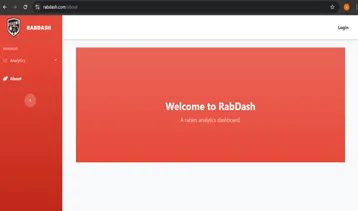HeaRTNovation
RabDash DC: Rabies Data Analytics Dashboard
TECHNOLOGY GENERATOR
Sherelyn A. Evangelio, MSc
University of the Philippines Mindanao
THE PROBLEM
Rabies remains a serious public health concern in the Philippines, particularly in urban areas like Davao City, where the high incidence of animal bites, limited surveillance capacity, and fragmented data reporting hinder timely and effective response. Local government units (LGUs) often struggle with inadequate access to reliable, real-time data to guide strategic planning and evaluate the effectiveness of interventions. Additionally, the lack of integration between epidemiological and genetic data limits the ability to trace virus transmission and anticipate outbreak patterns. These gaps reduce the impact of rabies control programs and delay the country’s progress toward a rabies-free status.
THE SOLUTION

RabDash DC is a web-based application that consolidates rabies surveillance data, including case incidence, vaccination coverage, and spatial distribution of animal bites. It incorporates epidemiological models, spatial analytics, and genomic data visualization to forecast rabies trends and assess the effectiveness of interventions. The system is designed to be user-friendly and is accessible to LGU personnel for operational use. This technology developed by the University of the Philippines Mindanao stands out from existing systems by combining epidemiological forecasting with genomic surveillance, offering a more comprehensive and proactive approach to rabies control.
Among its key features, the dashboard offers an interactive interface that visualizes real-time rabies data, hotspots, and outcomes of various interventions. It employs predictive analytics to estimate future rabies incidence and assess risk areas, enabling proactive public health responses. The integration of a genomic informatics module allows users to monitor the genetic characteristics of circulating rabies virus strains, helping trace sources of infection and transmission pathways. Additionally, the dashboard includes decision support tools that generate data-driven recommendations for targeted vaccination campaigns and community awareness efforts. Its integration into LGU operations empowers decision-makers with timely, localized, and actionable data. Compared to traditional data reporting systems, RabDash enhances precision, reduces response time, and promotes coordinated public health interventions.
In 2023, the project team received the “Pasidungog 2023, 2024 and 2025: Garbo sa Dabaw Award” from the City Government of Davao. This award recognized their commendable contribution and enduring commitment to improving animal health, welfare, and productivity through technological innovation.
TECHNOLOGY DEVELOPMENT STATUS
The technology is currently in Technology Readiness Level 9. RabDash DC is currently being utilized by the Davao City Veterinary Office, with training and user feedback already integrated into system enhancements. The software, including its user interface, was also granted copyright protection.
CURRENT NEEDS
The research team is actively seeking LGU partners for technology adoption, including LGUs for rabies control implementation, institutional collaborators for policy integration, and distributors to expand regional and national deployment.
CONTACT DETAILS
Technology Transfer and Business Development Office
University of the Philippines Mindanao
Coconut Tissue Culture Lab Bldg., Kalimudan St.,
University of the Philippines Mindanao, Mintal,Tugbok District, Davao City.
ttbd.upmindanao@up.edu.ph
+63917634128




